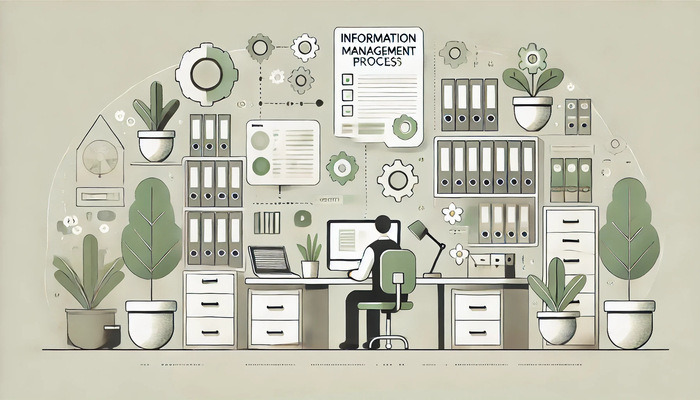
Information Management (IM) is a critical feature of modern organizational strategy, encompassing the systems and processes necessary for the effective creating, managing, and disseminating information. IM ensures that the right people have access to the right information at the right time, enabling the organization to utilize data strategically to achieve its objectives.
Information Management refers to the discipline that oversees the efficient management of information, from planning and systems development to disposal and archiving. The scope of IM is extensive, covering every aspect of how information is handled – from the initial design of information systems to day-to-day operations.
Effective IM can lead to better decision-making, enhanced efficiency and productivity, and competitive advantages in the marketplace. Conversely, poor IM practices can result in information silos, data breaches, and strategic missteps.
This article will delve into the details of the Information Management Process, analyze its key components, explore the lifecycle of information within an organization, and discuss the challenges faced by IM professionals. Additionally, we will examine different types of IM systems, best practices, and consider the future of IM, particularly in light of advancements in artificial intelligence and machine learning.
Understanding Information Management
The concept of IM revolves around the idea that information is a valuable resource that needs to be managed like any other strategic asset. The primary objectives of IM include:
- Ensuring information accessibility: Making sure that information is available to those who need it, when they need it.
- Maintaining information quality: Keeping information accurate, complete, and up-to-date.
- Protecting information integrity: Safeguarding information from unauthorized access.
- Facilitating information sharing: Encouraging the efficient distribution of information.
Information Management is integral to the smooth functioning of business operations. It supports informed decision-making by providing necessary data, enhances operational efficiency through streamlined processes, and improves customer relations by maintaining accurate and accessible customer information. Additionally, IM is essential for ensuring compliance with legal requirements and managing the risks associated with information handling.
Key Components of Information Management
Information Management involves a range of activities and processes. Here are the key components of IM that ensure information is handled efficiently and effectively throughout its lifecycle:
- data collection;
- data storage;
- data organization;
- data analysis;
- information distribution.
Let’s delve deeper into each of these components to understand their significance and how they contribute to effective information management.
Data Collection
Data collection is the first step in the information management process. It involves gathering information from various sources using methods such as surveys, observations, and transactions. Best practices in data collection include ensuring data accuracy, relevance, and completeness to facilitate effective decision-making.
Data Storage
Once collected, data must be stored securely and in a way that facilitates easy retrieval. Solutions for data storage range from on-premises databases to cloud storage services. Security measures are critical and include encryption, access controls, and security audits to protect data from unauthorized access.
Data Organization
Organizing data is essential for its effective use. Techniques such as categorization, indexing, and tagging help in structuring data. Tools like database management systems and content management systems play a vital role in data organization, allowing for efficient data retrieval and management.
Data Analysis
Data analysis transforms raw data into actionable insights. Approaches include statistical analysis, data mining, and predictive modeling. These methods help organizations identify trends, patterns, and relationships within the data, leading to informed strategic decisions.
Information Distribution
The final component of IM is the distribution of information. It ensures that the right information reaches the right people at the right time. This involves communication channels, collaboration tools, and information-sharing policies that align with the organization’s objectives.
By focusing on these key components, organizations can harness the power of information for growth, innovation, and competitive advantage.
Types of IM Systems with Examples
Information Management Systems (IMS) are crucial for organizations to process, manage, and analyze data. Here is an overview of the different types of IMS:
- Transaction Processing Systems (TPS). TPS are used to collect, store, modify, and retrieve the transactions of an organization. A real-life example is the Point of Sale (POS) system used in retail stores, which processes sales transactions, manages inventory, and handles customer purchases.
- Management Information Systems (MIS). MIS provide information that organizations require to manage themselves efficiently and effectively. For instance, FedEx uses an MIS for package tracking, customer account services, and route optimization.
- Decision Support Systems (DSS). DSS assist in making decisions by providing information, tools, and models. An example is American Airlines’ SABRE system, which helps in pricing, scheduling flights, and managing reservations.
- Executive Information Systems (EIS). EIS are designed to provide senior executives with access to internal and external information relevant to their strategic goals. General Electric (GE) uses an EIS for high-level data analysis and performance monitoring across its global operations.
- Customer Relationship Management (CRM) Systems. CRM systems help businesses manage customer data, interactions, and processes. Salesforce is a widely used CRM that offers a platform for sales, customer service, marketing automation, analytics, and application development.
- Knowledge Management Systems (KMS). KMS enable organizations to create, share, and manage knowledge. Microsoft SharePoint is an example of a KMS that facilitates document management, collaboration, and information sharing within and across enterprises.
By integrating these systems, organizations can streamline operations, enhance decision-making, and maintain a competitive edge in their respective industries.

The Information Management Lifecycle
The Information Management Lifecycle is a comprehensive framework that outlines the stages through which information passes during its useful life within an organization:
- Creation or capture. This stage involves generating new data or collecting existing information. For example, a hospital might capture patient data during registration using an Electronic Health Record (EHR) system.
- Maintenance and use. During this phase, information is regularly updated and utilized for various purposes. A business might use a Customer Relationship Management (CRM) system to maintain up-to-date contact details and interaction histories with clients.
- Archiving. Long-term storage strategies are implemented in this stage to ensure data preservation. Financial institutions, for instance, archive transaction records for regulatory compliance and future reference using secure databases.
- Destruction. Finally, the secure disposal of obsolete data is crucial to protect sensitive information. Companies often employ data destruction services to safely eliminate outdated documents following retention schedules.
Each stage of the IM Lifecycle plays a vital role in ensuring that information is managed responsibly and efficiently throughout its existence.
Best Practices in Information Management
Adopting best practices in Information Management is essential for organizations to handle data responsibly and efficiently. Below is an overview of these practices:
- Developing comprehensive policies and procedures. Organizations must establish clear policies and procedures to manage information effectively. For instance, IBM has developed detailed data governance policies that outline how data should be handled, ensuring consistency and security across its global operations.
- Selecting and implementing suitable technologies. Choosing the right technologies is crucial for effective IM. Google, for example, uses advanced cloud storage solutions to manage the vast amounts of data processed by its services, ensuring scalability and accessibility.
- Ongoing training and support for staff. Continuous training ensures that staff can manage and utilize information systems effectively. Accenture offers extensive training programs to its employees, keeping them updated on the latest IM technologies and practices.
- Commitment to continuous process improvement. A dedication to improving IM processes can lead to better efficiency and data quality. Toyota is known for its Kaizen philosophy, which applies to IM as well, focusing on continuous improvement in managing information.
By integrating these best practices, organizations can enhance their IM capabilities, leading to better decision-making and competitive advantage.
Information Management Tools and Technologies
Cutting-edge IM technologies include advanced software and systems designed to facilitate the storage, retrieval, management, and analysis of information. For example, Artificial Intelligence (AI) and Machine Learning (ML) algorithms are increasingly being integrated into IM tools to automate data analysis and decision-making processes. Blockchain technology is also being explored for its potential to enhance data security and integrity in IM systems.
When selecting IM tools, organizations should consider several criteria to ensure they choose the right technologies that align with their needs. These criteria include:
- Scalability. Can the tool grow with your organization? Amazon Web Services (AWS) offers cloud storage solutions that scale with the needs of the business.
- Security. Does the tool provide robust security features? Microsoft Azure implements advanced security protocols to protect data.
- Usability. Is the tool user-friendly? Salesforce provides a CRM platform with an intuitive interface for users.
- Integration. Can the tool integrate with existing systems? SAP offers enterprise resource planning software that integrates with various business applications.
- Support. Does the vendor offer reliable customer support? Oracle is known for providing comprehensive support for its database management systems.
By carefully evaluating these criteria, organizations can select the most suitable IM tools and technologies that will support their information management strategies effectively.

Conclusion
A robust Information Management process is the backbone of any successful organization. It ensures that information is accurate, accessible, and secure, which is vital for making informed decisions. For example, healthcare providers rely on robust IM processes to maintain patient records, ensuring that critical health information is available when needed for treatment decisions.
Organizations must not only establish strong IM practices but also encourage proactive engagement with these practices among all stakeholders. For instance, financial institutions actively engage employees in IM practices to comply with regulatory requirements and protect sensitive customer data.
By summarizing the importance of IM and encouraging proactive engagement, organizations can safeguard their information assets and use them to drive business success and innovation.
Good luck with your technical writing!
ClickHelp Team
Author, host, and deliver documentation across platforms and devices.



